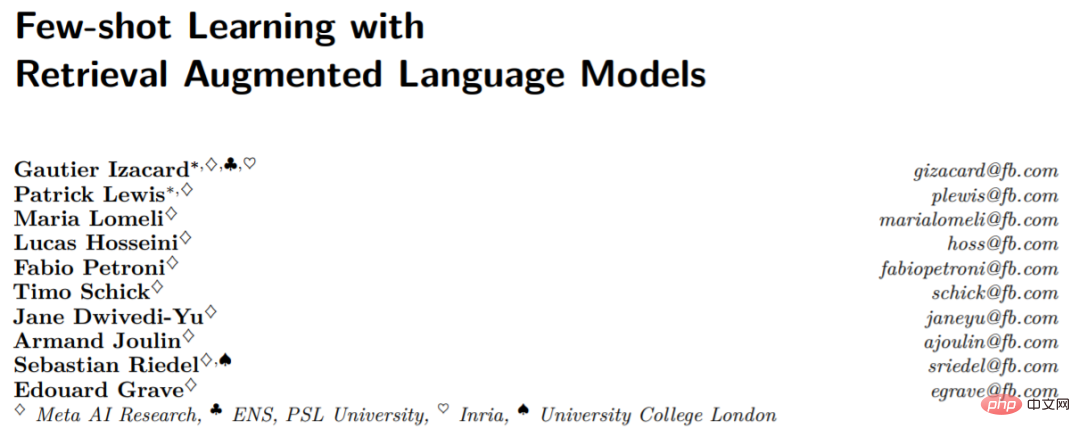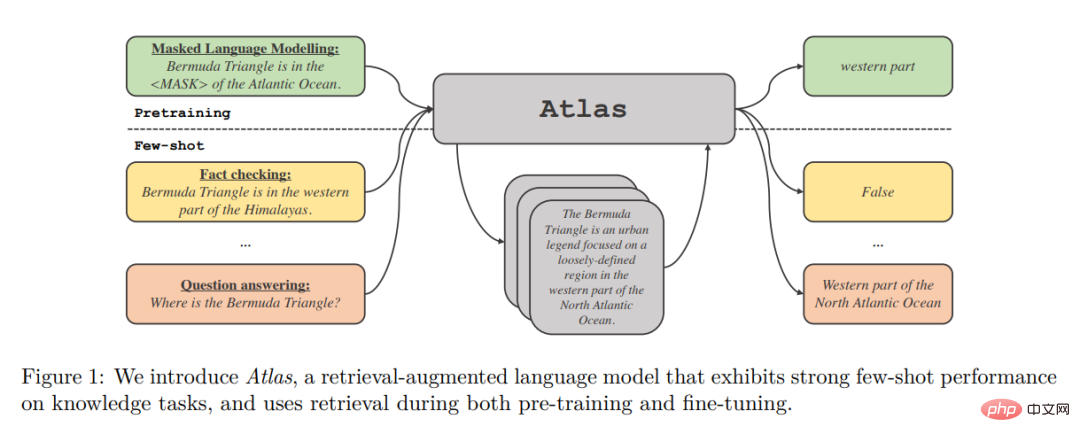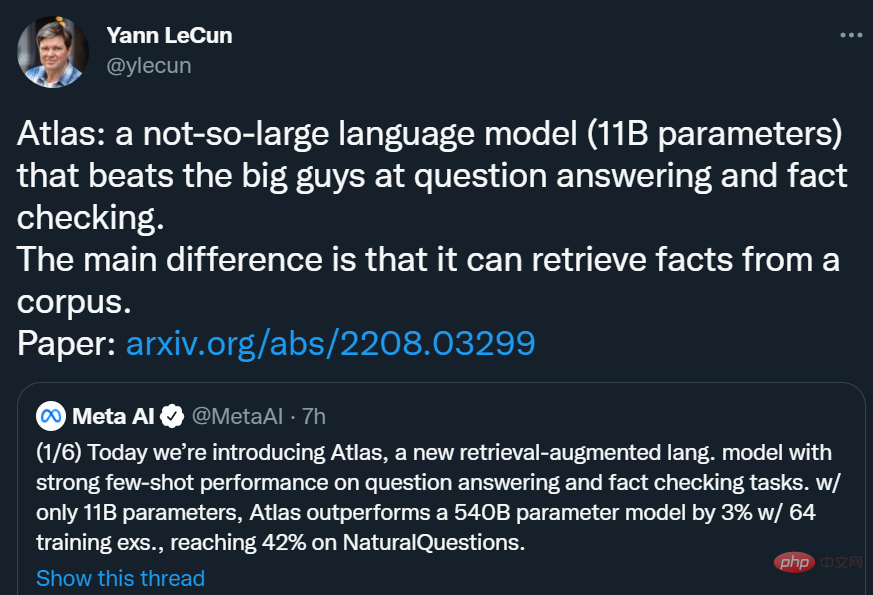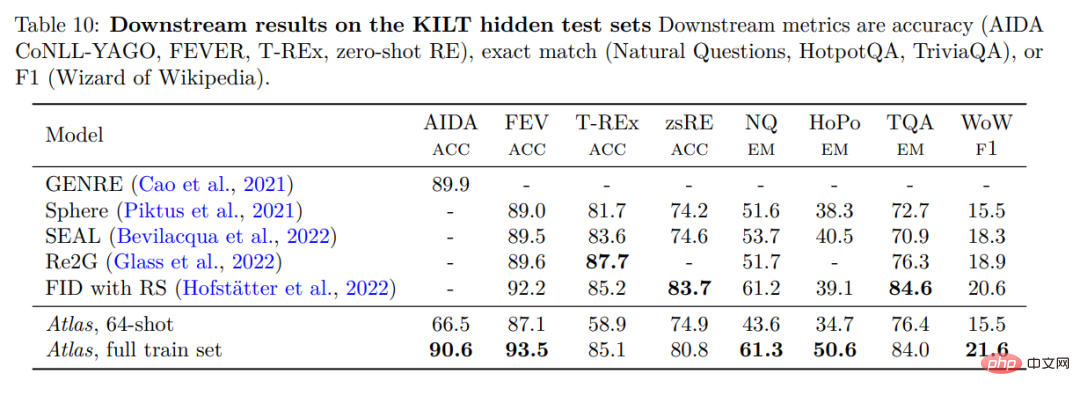
We can understand large language models (LLMs) as small sample learners, which can learn new tasks with few examples, or even learn with only simple instructions, where the number of model parameters is Scaling with the size of the training data is key to the model's ability to generalize. This improvement in LLMs is due to greater computing power and storage capabilities. Intuitively, improved inference capabilities will lead to better generalization and thus less sample learning, however it is unclear to what extent effective small sample learning requires extensive knowledge of model parameters.
So far, retrieval enhancement models have not demonstrated convincing small-sample learning capabilities. In the paper, researchers from Meta AI Research and other institutions ask whether small sample learning requires the model to store a large amount of information in its parameters, and whether storage can be decoupled from generalization. They proposed Atlas, which is a type of retrieval-enhanced language model that has strong small-sample learning capabilities, even though the number of parameters is lower than other current powerful small-sample learning models.
The model uses non-parametric storage, that is, using a neural retriever based on large external non-static knowledge sources to enhance the parametric language model. In addition to storage capabilities, such architectures are attractive due to their advantages in adaptability, interpretability, and efficiency.

Paper address: https://arxiv.org/pdf/2208.03299.pdf
Atlas retrieval of related documents is a universal density retriever based on the Contriever dual-encoder architecture. When retrieving files, it retrieves related files based on the current context. The retrieved documents along with the current context are processed by a sequence-to-sequence model that uses the Fusion-in-Decoder architecture to generate the corresponding output.
The authors study the impact of different techniques on the performance of training Atlas on small-scale datasets on a range of downstream tasks, including question answering and fact checking. The study found that the joint pre-training component is crucial for small sample performance, and the authors evaluated many existing and novel pre-training tasks and schemes. Atlas has strong downstream performance in both small sample and resource-rich environments.
With only 11B parameters, Atlas achieved 42.4% accuracy on NaturalQuestions (NQ) using 64 training examples, which is higher than the 540B parameter model PaLM (39.6%) out nearly 3 percentage points, reaching an accuracy of 64.0% in the full data set setting (Full).

Yann LeCun said: Atlas is a not too big language model (11B parameters), in Q&A and Facts Beats the "big guy" in verification. The main difference of Atlas is that it can retrieve facts from a corpus.

Atlas follows a text-to-text framework. This means that the general framework of all tasks is: the system takes a text query as input and generates text output. For example, in the case of question and answer tasks, the query corresponds to a question and the model needs to generate an answer. In the case of classification tasks, the query corresponds to text input and the model generates class labels, i.e., the words corresponding to the labels. The KILT benchmark in Figure 2 gives more examples of downstream tasks. Many natural language processing tasks require knowledge, and Atlas aims to enhance standard text-to-text models with retrieval, since retrieval may be critical to the model's ability to learn in small sample scenarios.

The Atlas model is based on two sub-models: the retriever and the language model. When performing a task, from question answering to generating Wikipedia articles, the model first retrieves the top k relevant documents from a large text corpus through a retriever. These documents, along with the query, are then given as input to the language model, which generates output. Both the retriever and the language model are based on pre-trained transformer networks, which are described in detail below.
Retrieval: Atlas's retriever module is based on Contriever, an information retrieval technology based on continuous density embedding. Contriever uses a dual-encoder architecture where queries and documents are independently embedded by transformer encoders. Average pooling is applied to the output of the last layer to obtain a vector representation of each query or document. Then by calculating the dot product of the mutual embeddings between the query and each document, their similarity scores are obtained. The Contriever model is pre-trained using the MoCo contrastive loss and uses only unsupervised data. One of the advantages of density retrievers is that both query and document encoders can be trained without document annotations using standard techniques such as gradient descent and distillation.
Language model: For language model, Atlas relies on the T5 sequence-to-sequence architecture. The model also relies on a Fusion-in-Decoder modification of the sequence-to-sequence model and processes each document independently in the encoder. The model then concatenates the outputs of the encoders corresponding to different documents and performs cross-attention on a single sequence in the decoder. The model connects the query to each document in the encoder. Another way to process retrieved documents in a language model is to concatenate the query and all documents and use this long sequence as input to the model. But this method is less scalable, that is, it will not scale as the number of documents increases, because the self-attention mechanism in the encoder will lead to a time complexity of O(n^2) (where n is the number of documents ).
The authors evaluate Atlas on two open-domain question answering benchmarks, NaturalQuestions and TriviaQA. And a small sample data set of 64 samples and a complete training set were used to compare with previous work. The detailed comparison is shown in the table below.

Performs best in 64-shot question answering with NaturalQuestions and TriviaQA. In particular it outperforms larger models (PaLM) or models that require more training computations (Chinchilla). Atlas can also achieve optimal results when using the full training set, such as increasing the accuracy of NaturalQuestions from 55.9% to 60.4%. This result was obtained under the default settings of Atlas, using an index consisting of CCNet and the December 2021 Wikipedia corpus. The table below shows the test results on the fact-checking dataset FEVER.

Atlas In the 64-shot case, the training samples are sampled from the full training set. Atlas achieved an accuracy of 64.3%. In the 15-shot case, 5 samples are uniformly sampled from each class. Compared with the Gopher results, the Atlas accuracy is 56.2%, which is 5.1 percentage points higher than Gopher. The Atlas model was fine-tuned on the full training set and achieved an accuracy of 78%, which is 1.5% lower than ProoFVer. ProoFVer uses a specialized architecture to train retrievers with sentence-level annotations and is provided by the Wikipedia corpus published with FEVER, while Atlas retrieves from CCNet and the December 2021 Wikipedia dump. When given an index consisting of the FEVER Wikipedia corpus, Atlas achieved an optimal level of 80.1%.
To validate the performance of Atlas, Atlas was evaluated on KILT, a benchmark consisting of several different knowledge-intensive tasks. The table below shows the results on the test set.

Atlas 64-shot far outperformed random algorithms in experiments and even matched some fine-tuned ones on the leaderboard The models are comparable. For example, on FEVER, Atlas 64-shot is only 2-2.5 points behind Sphere, SEAL and Re2G, while on zero-shot RE it outperforms Sphere and SEAL. On the full dataset, Atlas’ performance is within 3% of the best model in 3 datasets, but it is the best in the remaining 5 datasets.
The above is the detailed content of The number of parameters is 1/50, Meta releases 11 billion parameter model, defeating Google PaLM. For more information, please follow other related articles on the PHP Chinese website!




